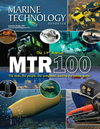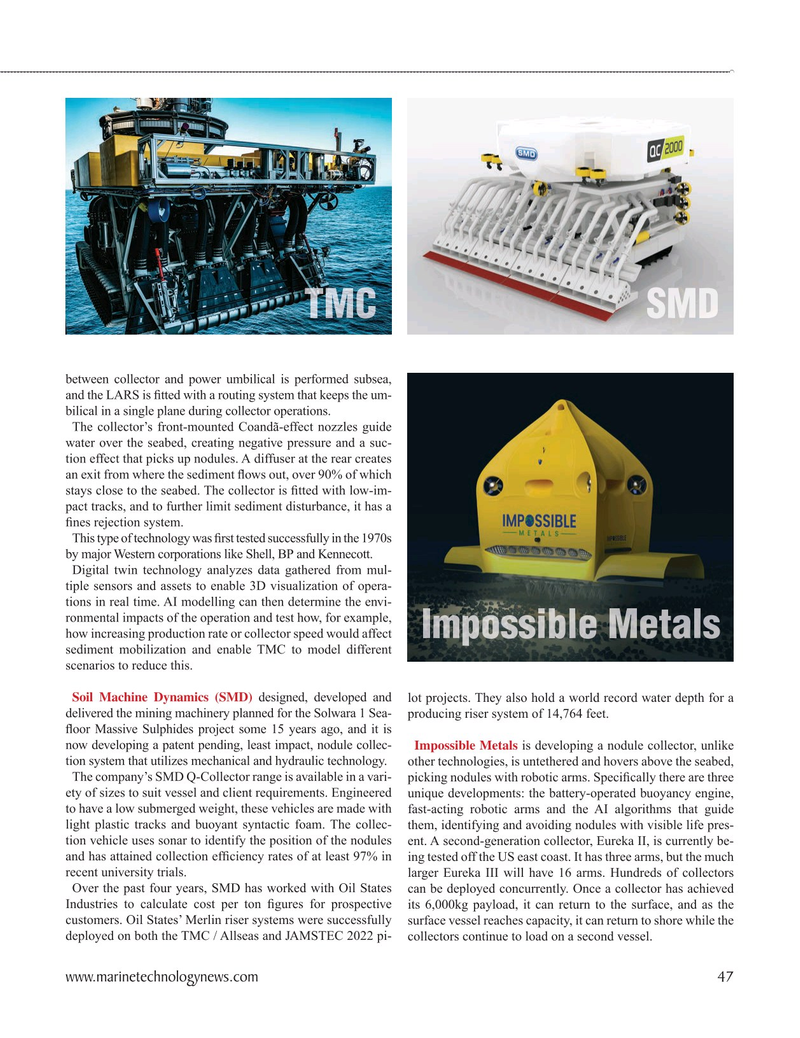
Page 47: of Marine Technology Magazine (September 2024)
Read this page in Pdf, Flash or Html5 edition of September 2024 Marine Technology Magazine
between collector and power umbilical is performed subsea, and the LARS is ? tted with a routing system that keeps the um- bilical in a single plane during collector operations.
The collector’s front-mounted Coandã-effect nozzles guide water over the seabed, creating negative pressure and a suc- tion effect that picks up nodules. A diffuser at the rear creates an exit from where the sediment ? ows out, over 90% of which stays close to the seabed. The collector is ? tted with low-im- pact tracks, and to further limit sediment disturbance, it has a ? nes rejection system.
This type of technology was ? rst tested successfully in the 1970s by major Western corporations like Shell, BP and Kennecott.
Digital twin technology analyzes data gathered from mul- tiple sensors and assets to enable 3D visualization of opera- tions in real time. AI modelling can then determine the envi- ronmental impacts of the operation and test how, for example, how increasing production rate or collector speed would affect sediment mobilization and enable TMC to model different scenarios to reduce this.
Soil Machine Dynamics (SMD) designed, developed and lot projects. They also hold a world record water depth for a delivered the mining machinery planned for the Solwara 1 Sea- producing riser system of 14,764 feet.
? oor Massive Sulphides project some 15 years ago, and it is now developing a patent pending, least impact, nodule collec- Impossible Metals is developing a nodule collector, unlike tion system that utilizes mechanical and hydraulic technology. other technologies, is untethered and hovers above the seabed,
The company’s SMD Q-Collector range is available in a vari- picking nodules with robotic arms. Speci? cally there are three ety of sizes to suit vessel and client requirements. Engineered unique developments: the battery-operated buoyancy engine, to have a low submerged weight, these vehicles are made with fast-acting robotic arms and the AI algorithms that guide light plastic tracks and buoyant syntactic foam. The collec- them, identifying and avoiding nodules with visible life pres- tion vehicle uses sonar to identify the position of the nodules ent. A second-generation collector, Eureka II, is currently be- and has attained collection ef? ciency rates of at least 97% in ing tested off the US east coast. It has three arms, but the much recent university trials. larger Eureka III will have 16 arms. Hundreds of collectors
Over the past four years, SMD has worked with Oil States can be deployed concurrently. Once a collector has achieved
Industries to calculate cost per ton ? gures for prospective its 6,000kg payload, it can return to the surface, and as the customers. Oil States’ Merlin riser systems were successfully surface vessel reaches capacity, it can return to shore while the deployed on both the TMC / Allseas and JAMSTEC 2022 pi- collectors continue to load on a second vessel. www.marinetechnologynews.com 47
MTR #7 (34-49).indd 47 10/3/2024 12:18:32 PM

 46
46

 48
48
